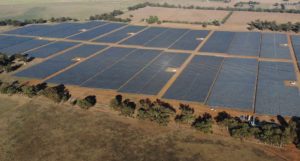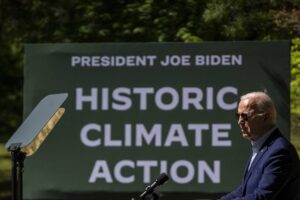Most global fashion brands are lagging on climate action, a new fossil-free fashion scorecard has found.
Canadian environmental advocacy group Stand.earth ranked 47 major clothing labels based on each brand’s climate targets, renewable energy use and advocacy, low carbon materials and greener shipping.
“The runway is getting shorter for companies to move from commitments to actions, and take the steps necessary to drastically reduce their greenhouse gas emissions in the next decade”, Stand.earth climate campaigner Muhannad Malas said.
Twenty companies received an F for fail, with the bottom dwellers in the scorecard including Uniqlo, Marks&Spencer and Esprit.
Outdoorwear company Mammut and sportswear retailer Nike came out in front, earning a B+ and C- respectively.
Mammut scored the highest mark for its commitment to halving emissions, powering its supply chain with renewable energy and shifting to zero emission shipping by 2030. The company aims to phase out all coal use in its supply chain, reduce reliance on fossil fuel based materials and cut waste.
The scorecard comes as a spotlight is being shone on the climate and environmental impacts of the fashion industry both internationally and in Australia.
Swedish climate activist Greta Thunberg called out the fashion industry’s huge contribution to the climate and ecological emergency. Vogue Australia reported that sustainability is now a core consideration for new fashion brands, with climate, emissions and waste a focus.
The fashion industry is a huge contributor to the climate-and ecological emergency, not to mention its impact on the countless workers and communities who are being exploited around the world in order for some to enjoy fast fashion that many treat as disposables. 1/3 pic.twitter.com/pZirCE1uci
— Greta Thunberg (@GretaThunberg) August 8, 2021
In Australia, both federal and Victorian governments have made textiles a priority focus for waste and circular economy policies this year.
The fashion industry is an “interesting mix of environmental and social problems” according to Professor Lesley Hughes. Hughes is a councillor at the Climate Council which has published an explainer on fashion and climate.
“It’s not just emissions, the water use in textile production is enormous. And then there’s the dyes, chemical pollution, microfibre pollution… and that all intersects with the social aspects, of the sort of factories in Bangladesh and slave labour.”
“Fashion is a major economic sector that relies on finite resources”, Aleasha McCallion, co-founder of the circular textiles program at Monash University’s Sustainable Development Institute told RenewEconomy.
Greening the supply chain for the fashion and textiles industry is crucial but complex, she said.
The industry’s reach extends right back to farmers growing cotton or wool (or the companies extracting petrochemicals for synthetic fabrics), the manufacturing and production of materials, components and garments, transport and distribution, and then on to the retailers, customers and ultimately landfill, reuse or recycling.
McCallion added that while fashion commitments on climate were important, significant amounts of textiles are also used in interior furnishings and carpet production, parts of the industry that have received little attention to date.
McCallion is an author of A better t-shirt, a circular economy guide recently launched by Victorian energy, environment and climate change minister D’Ambrosio.
The guide lists using fossil fuels and non-renewable energy in fabrics and textile production as examples of “not circular” practices. Whereas “circular” fashion includes using natural and recycled materials, durable fabrics, renewable energy in manufacturing and increased use of garments through repair, reuse and rental.
Sydney based t-shirt brand Citizen Wolf is an example of an Australian company using world-leading technology to reduce emissions and waste, McCallion said.
Citizen Wolf manufactures its t-shirts from organic and sustainable fabrics on demand, instead of enmasse. Manufacturing to order reduces emissions from unnecessary production. The brand then purchases climate offsets for five times its emissions, to go “carbon negative”.
The company uses an artificial intelligence algorithm to design and produce custom fit t-shirts without the need for measuring tapes. It offers free repairs for the life of each garment and recycles offcuts into other products like tote bags and scarfs.
Other Australian brands are also increasing their focus on sustainability.
A significant and recent shift in Australia has been the way major Australian brands are now employing sustainability managers, McCallion said.
Kmart, Global Fashion Group, Kathmandu, Country Road, Elk, Bassike and RM Williams have all employed sustainability managers according to industry publication Ragtrader.
A key driver for fashion brands is that three in four (73 per cent) Australian consumers agree ethical fashion is important. As many as 87 per cent would like to change their consumption habits to be more ethical, a 2021 survey by McCrindle for Baptist World Aid found.
The survey of more than 2,000 Australians found barriers included knowing which brands are sustainable, and the higher cost of ethical fashion.
Australian consumers spend an estimated $28.5 billion on fashion each year. The Australian fashion and textiles industry exports $6 billion in products each year and employs around 220,000 people nationally.
There are various estimates for greenhouse gas emissions from the fashion and textile industry. A study in The Journal of Cleaner Production suggests the fashion industry contributes to 2.4 per cent of global emissions, with the vast majority of emissions and environmental impacts occurring prior to retail sale. The World Economic Forum puts the number at around 10 per cent of global greenhouse emissions.
In 2018, the industry launched the Fashion Industry Charter for Climate Action. Kmart and Target are both signatories of the charter which includes a commitment to reduce emissions by 30 percent in direct, electricity and supply chain emissions by 2030.










